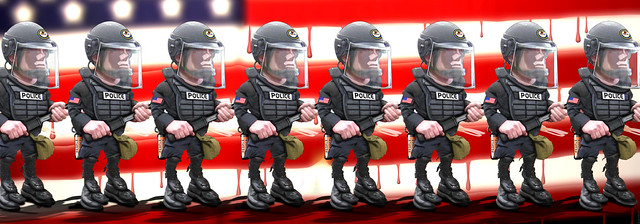Nine months after police in Ferguson, Missouri donned riot gear, and met protestors with paramilitary weapons and equipment, the Obama administration has taken its first real steps towards halting police militarization.
As the president prepared for a visit to Camden, New Jersey — one of the nation’s poorest, most violent cities — the White House announced a series of recommendations to regulate the flow of paramilitary weapons and equipment to local police departments. The recommendations divide weapons and equipment into two categories:
- “Prohibited” equipment — including bayonets, grenade launchers, weaponized aircraft, tracked armored vehicles and large caliber weapons — that may not be distributed to local police departments “under any circumstances.”
- “Controlled” equipment — including riot gear, explosives, armored vehicles, and specialized firearms — which police departments may only receive if they comply with “new and more rigorous controls.”
Those “new and more rigorous controls” include stringent federal oversight and restrictions, as well as local approval. Police departments will have to adopt General Policing Standards (including “training on community policing, constitutional policing, and community impact”); “agree to protocols on the appropriate use, supervision, and operation of such equipment”; and “collect and retain certain information whenever such equipment is involved in a ‘significant incident.’” In addition, local police departments will have to obtain approval from an “appropriate local civilian governing body (e.g., City Council, County Council, Mayor),” and present a “clear and persuasive explanation” for what they need such equipment, and what appropriate law enforcement purpose it will serve.
The recommendations far exceed the minimal requirements of the Pentagon’s “Program 1033,” which distributed $4.3 billion in military weapons and equipment to local police departments. Since 1992, police departments received “surplus” military weapons and equipment (paid for out of a bloated defense budget) “free of charge,” as long as they claimed that they were part of a “High Intensity Drug Trafficking Area.”
The new recommendations are a welcome surprise, and a long-awaited step in the right direction. Proponents of policing reform have been disappointed by earlier preliminary reports and recommendations which suggested the administration would leave such programs in place. However, the Associated Press reports that an intra-agency group found that “substantial risk of misusing or overusing” of things like armored vehicles, high-powered firearms and camouflage undermined public trust in police (thus undermining the goal of increasing trust between communities and police forces).
The recommendations are part of a “Creating Opportunity for All Through Stronger, Safer Communities,” the president will highlight during his Camden visit, which includes the following tools:
- A Blueprint for Improved Community Policing: The final Task Force Report provides a blue print for cities and towns to utilize as they develop policing strategies that work best for building trust between law enforcement and the communities they serve while enhancing public safety.
- The White House Police Data Initiative: Leading jurisdictions have joined technologists, community organizations and police associations to commit to use data and technology in ways that build community trust and reduce unnecessary uses of force.
- Community Policing Grants: The Department of Justice (DOJ) will begin taking applications for grants designed to advance the practice of community policing in law enforcement agencies through hiring, training and technical assistance, the development of innovative community policing strategies, applied research, guidebooks, and best practices that are national in scope.
- A Body-Worn Camera Tool Kit: Earlier this month, the DOJ announced a new pilot grant program that will help local law enforcement agencies develop, implement, and evaluate body-worn camera programs, and today, DOJ is releasing an online clearinghouse of resources designed to help law enforcement professionals and the communities they serve plan and implement body-worn camera (BWC) programs.
- Partnerships with National Law Enforcement Focused Organizations to Implement Recommendations: With support from the Department of Justice, nine law enforcement-focused organizations will develop national-level, industry-wide projects for several of the pillars outlined in the Task Force Report.


